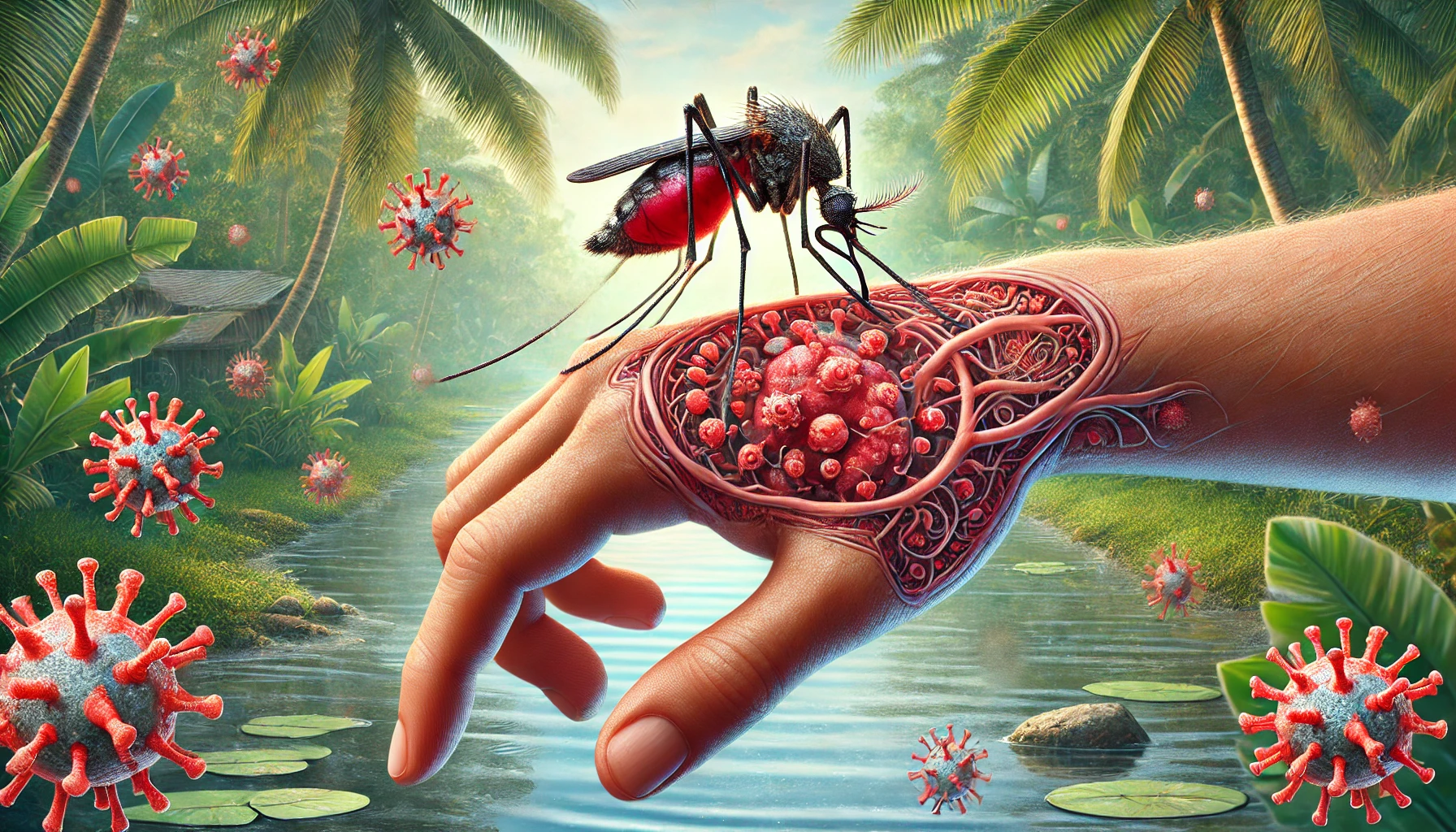Chikungunya is a viral disease transmitted to humans by infected mosquitoes. It is characterized by sudden fever, severe joint pain, and a range of other symptoms that can be debilitating. Though it is rarely fatal, the condition can significantly impact a person’s quality of life due to prolonged joint pain and fatigue. In this article, we will delve deep into the causes, symptoms, treatment, and prevention of Chikungunya while integrating top SEO keywords for better accessibility and readability.
Chikungunya, a mosquito-borne viral disease, has been a persistent health concern in India, with significant outbreaks reported over the years. In 2024, the country experienced a notable surge in cases, with the National Center for Vector Borne Diseases Control reporting 192,343 cases, slightly down from 200,064 in 2023.
The primary vectors for Chikungunya in India are the Aedes aegypti and Aedes albopictus mosquitoes, which thrive in tropical and subtropical climates. These mosquitoes breed in stagnant water sources commonly found in urban and rural settings, such as water storage containers, discarded tires, and flower pots. The monsoon season exacerbates this issue, creating ample breeding grounds and leading to increased transmission rates.
The 2024 outbreak was particularly severe in Maharashtra, with the state reporting a significant number of cases. The National Institute of Virology in Pune conducted studies to determine if specific Chikungunya virus variants, particularly the Indian Ocean Lineage, were contributing to the increased case numbers and prolonged symptoms observed during this period.
Chikungunya presents with symptoms such as high fever, severe joint pain, muscle pain, headache, nausea, fatigue, and rash. While the disease is rarely fatal, the joint pain can be debilitating and may persist for months, affecting the quality of life of those infected. The similarity of symptoms with other vector-borne diseases like dengue and Zika poses challenges for accurate diagnosis and treatment.
Table of Contents
Chikungunya: Causes, Symptoms, Prevention, and Treatment
Causes and Transmission of Chikungunya.
Chikungunya vs. Dengue vs. Zika: Key Differences.
In response to the outbreak, public health authorities in India have emphasized the importance of preventive measures:
- Mosquito Control: Efforts include eliminating breeding sites, promoting the use of insecticide-treated nets, and conducting regular fumigation drives in affected areas.
- Public Awareness: Educational campaigns aim to inform communities about the importance of removing stagnant water, using mosquito repellents, and wearing protective clothing to reduce mosquito bites.
- Surveillance and Research: Continuous monitoring of Chikungunya cases and vector populations helps in understanding transmission patterns. Research into vaccine development is ongoing, though no vaccine is currently available for public use.
The recurrence of Chikungunya outbreaks in India underscores the need for sustained public health efforts, community engagement, and research to develop effective vaccines and treatments. Individuals are encouraged to take proactive measures to protect themselves and their communities from mosquito bites, especially during peak transmission seasons.
What is Chikungunya?
Chikungunya is a mosquito-borne viral infection caused by the Chikungunya virus (CHIKV). The virus belongs to the Togaviridae family and is primarily transmitted by the Aedes aegypti and Aedes albopictus mosquitoes. These mosquitoes are also responsible for spreading other deadly diseases like dengue and Zika virus.
The term “Chikungunya” originates from the Makonde language of Tanzania, meaning “to become contorted,” referring to the stooped posture of individuals suffering from severe joint pain caused by the infection.
Causes and Transmission of Chikungunya
1. Mosquito Bites
The primary mode of Chikungunya transmission is through the bite of an infected mosquito. The Aedes species of mosquitoes, which typically bite during the daytime, are the main vectors of the virus. These mosquitoes breed in stagnant water found in discarded containers, old tires, flower pots, and water storage tanks.
2. Human-to-Mosquito-to-Human Cycle
When an uninfected mosquito bites an individual already infected with the virus, the mosquito becomes a carrier and can transmit the virus to another person through a subsequent bite. This cycle contributes to the rapid spread of the disease, especially in tropical and subtropical regions.
Symptoms of Chikungunya
Symptoms of Chikungunya usually appear within 4-7 days after being bitten by an infected mosquito. Some of the most common symptoms include:
1. High Fever
A sudden and intense fever (often exceeding 102°F) is one of the earliest signs of Chikungunya. This fever usually lasts for about 2-3 days.
2. Severe Joint Pain
One of the most distinguishing symptoms of Chikungunya is severe joint pain, which can persist for weeks or even months. The pain is often concentrated in the wrists, ankles, fingers, and knees.
3. Muscle Pain and Fatigue
Many individuals experience intense muscle pain and fatigue, making it difficult to perform daily activities.
4. Rash
A skin rash, often appearing as red patches or spots, is another common symptom. This rash typically appears a few days after the fever subsides.
5. Headache and Nausea
Some patients experience severe headaches, nausea, and vomiting, further contributing to discomfort.

Who is at Risk?
Certain individuals are more susceptible to severe Chikungunya infections, including:
- Elderly Individuals: Older adults are more likely to experience prolonged symptoms and complications.
- Infants and Young Children: Babies born to infected mothers may develop complications.
- People with Pre-Existing Conditions: Individuals with diabetes, heart disease, and weakened immune systems are at greater risk of severe illness.
Diagnosis of Chikungunya
Chikungunya is often confused with other mosquito-borne illnesses like dengue and Zika virus. Proper diagnosis is crucial for effective treatment. Medical professionals use the following diagnostic methods:
1. Blood Tests
Laboratory blood tests can detect Chikungunya virus RNA or specific antibodies (IgM and IgG) in the patient’s blood.
2. Clinical Examination
Doctors assess the patient’s symptoms and recent travel history to endemic areas to make an informed diagnosis.
Treatment for Chikungunya
Currently, there is no specific antiviral treatment or cure for Chikungunya. The primary focus of treatment is symptom relief and supportive care.
1. Pain and Fever Management
Doctors recommend over-the-counter medications such as paracetamol or ibuprofen to reduce fever and relieve joint pain. Aspirin should be avoided, especially in suspected cases of dengue, as it can increase the risk of bleeding.
2. Hydration
Staying hydrated is essential to prevent dehydration caused by fever and excessive sweating.
3. Rest and Recovery
Getting adequate rest allows the body to fight off the infection effectively. Patients are advised to avoid strenuous activities until they fully recover.
4. Physiotherapy
For individuals experiencing prolonged joint pain, physiotherapy and light exercise may help in regaining mobility and reducing discomfort.
Prevention of Chikungunya
Since no vaccine is currently available for Chikungunya, prevention is key to reducing its spread. Here are some essential preventive measures:
1. Mosquito Control Measures
- Eliminate Breeding Grounds: Regularly empty and clean containers that collect water, such as flower pots, bird baths, and gutters.
- Use Mosquito Nets: Sleeping under mosquito nets can prevent bites, especially in areas with high mosquito activity.
- Install Window and Door Screens: This helps prevent mosquitoes from entering indoor spaces.
2. Personal Protection
- Wear Protective Clothing: Wearing long-sleeved shirts, pants, and socks can reduce mosquito exposure.
- Use Insect Repellents: Applying DEET-based or natural insect repellents can keep mosquitoes at bay.
- Avoid Peak Mosquito Hours: Mosquitoes that carry the Chikungunya virus are most active during early morning and late afternoon.
Chikungunya vs. Dengue vs. Zika: Key Differences
Many people confuse Chikungunya with dengue and Zika due to their similar symptoms. Here are the primary differences:
| Feature | Chikungunya | Dengue | Zika |
| Fever | High, sudden | High, fluctuating | Mild or none |
| Joint Pain | Severe and prolonged | Mild | Mild |
| Rash | Common | Sometimes | Common |
| Bleeding Symptoms | Rare | Common | Rare |
| Neurological Complications | Rare | Rare | Common (microcephaly in newborns) |
Global Impact and Outbreaks
Chikungunya outbreaks have occurred in Africa, Asia, the Caribbean, and parts of the Americas. The disease was first identified in Tanzania in 1952 and has since spread to many countries due to increased global travel and climate changes favoring mosquito breeding.
Future Prospects: Vaccine Development
Currently, several research institutions are working on developing a Chikungunya vaccine. While no vaccine is available for commercial use yet, clinical trials are ongoing to create an effective solution for long-term immunity.

Top 25 FAQ’s
Here are the top 25 frequently asked questions (FAQs) about Chikungunya:
1. What is Chikungunya?
Chikungunya is a viral disease transmitted to humans by infected mosquitoes, primarily the Aedes aegypti and Aedes albopictus species. The disease is characterized by sudden onset of fever and severe joint pain.
2. What are the common symptoms of Chikungunya?
The main symptoms include high fever, severe joint pain, muscle pain, headache, rash, fatigue, and nausea. Symptoms typically appear 4–7 days after being bitten by an infected mosquito.
3. How is Chikungunya transmitted?
Chikungunya is spread through the bite of infected female Aedes mosquitoes, which are also responsible for transmitting dengue and Zika viruses.
4. Can Chikungunya be transmitted from person to person?
No, Chikungunya is not directly transmitted from person to person. It spreads only through mosquito bites.
5. How long do Chikungunya symptoms last?
Most symptoms last for about a week, but joint pain may persist for weeks or even months in some cases.
6. Is Chikungunya a life-threatening disease?
Chikungunya is rarely fatal, but the joint pain can be severe and long-lasting, significantly impacting the quality of life.
7. Is there a vaccine for Chikungunya?
As of now, there is no commercially available vaccine for Chikungunya. Prevention is mainly through mosquito control and personal protection.
8. What treatments are available for Chikungunya?
There is no specific antiviral treatment. Management includes rest, hydration, and medications like paracetamol or ibuprofen to relieve pain and fever.
9. Can Chikungunya cause chronic illness?
Yes, some people experience prolonged joint pain, similar to arthritis, which may last for months or even years.
10. Who is at higher risk of complications from Chikungunya?
Infants, the elderly, and individuals with pre-existing conditions such as diabetes, heart disease, or weakened immune systems are at higher risk.
11. How can Chikungunya be prevented?
Preventive measures include eliminating mosquito breeding sites, using insect repellents, wearing protective clothing, and using mosquito nets.
12. Where is Chikungunya most common?
Chikungunya is prevalent in tropical and subtropical regions, including Africa, Asia, the Caribbean, and parts of the Americas.
13. How is Chikungunya diagnosed?
Diagnosis is confirmed through blood tests detecting Chikungunya virus RNA, IgM, or IgG antibodies.
14. Can Chikungunya recur?
Once a person is infected, they develop immunity and are unlikely to get the disease again. However, joint pain may recur for months.
15. How does Chikungunya differ from Dengue?
Both are mosquito-borne viral diseases, but Chikungunya primarily causes severe joint pain, whereas dengue is associated with bleeding and severe flu-like symptoms.
16. Can pregnant women get Chikungunya?
Yes, pregnant women can contract Chikungunya, but transmission to the baby is rare except during childbirth.
17. Can Chikungunya be mistaken for other diseases?
Yes, symptoms can resemble dengue, Zika, malaria, or rheumatic diseases, requiring lab tests for confirmation.
18. What is the incubation period of Chikungunya?
The incubation period is typically 3–7 days after being bitten by an infected mosquito.
19. Does Chikungunya affect animals?
No, Chikungunya primarily affects humans and does not infect household pets or livestock.
20. Can I travel if I have Chikungunya?
It is recommended to rest and recover before traveling, as joint pain and fatigue may make travel uncomfortable.

21. Is Chikungunya seasonal?
Chikungunya outbreaks often occur during or after rainy seasons when mosquito populations are high.
22. Can Chikungunya cause neurological issues?
In rare cases, severe Chikungunya infections have been linked to neurological complications such as encephalitis and Guillain-Barré syndrome.
23. What should I do if I suspect I have Chikungunya?
Consult a doctor for diagnosis and symptom management. Avoid mosquito bites to prevent further transmission.
24. Can Chikungunya lead to death?
Fatalities are rare, but complications can be severe in older adults or those with underlying health conditions.
25. How is Chikungunya controlled in affected regions?
Health authorities use mosquito control strategies like insecticide spraying, removing breeding sites, and public awareness campaigns to reduce transmission.
Conclusion
Chikungunya is a serious but preventable mosquito-borne disease. While there is no specific cure, supportive care and preventive measures can help manage symptoms and reduce the risk of infection. Eliminating mosquito breeding sites, using personal protection measures, and spreading awareness are essential steps toward controlling Chikungunya outbreaks. Ongoing research in vaccine development offers hope for a future where this disease can be effectively prevented.
By following the recommended precautions and seeking medical attention if symptoms appear, individuals can safeguard themselves against this debilitating illness. As public health efforts continue worldwide, the goal is to minimize the impact of Chikungunya and protect communities from its effects.
Curated Articles






You have brought up a very wonderful details, thankyou for the post.